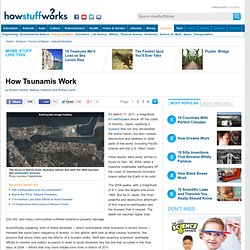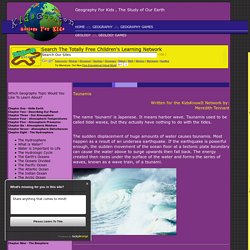

Tsunami Facts, Tsunami Information, Tsunami Videos, Tsunami Photos. A tsunami is a series of ocean waves that sends surges of water, sometimes reaching heights of over 100 feet (30.5 meters), onto land.

These walls of water can cause widespread destruction when they crash ashore. These awe-inspiring waves are typically caused by large, undersea earthquakes at tectonic plate boundaries. When the ocean floor at a plate boundary rises or falls suddenly it displaces the water above it and launches the rolling waves that will become a tsunami. Most tsunamis, about 80 percent, happen within the Pacific Ocean’s “Ring of Fire,” a geologically active area where tectonic shifts make volcanoes and earthquakes common. Tsunamis may also be caused by underwater landslides or volcanic eruptions. Tsunamis race across the sea at up to 500 miles (805 kilometers) an hour—about as fast as a jet airplane. In deep ocean, tsunami waves may appear only a foot or so high. A tsunami’s trough, the low point beneath the wave’s crest, often reaches shore first.
BBC Earth - Tsunamis videos - How these dangerous waves form. Tsunamis. How Tsunamis Work" On March 11, 2011, a magnitude 9.0 earthquake struck off the coast of Honshu, Japan, sparking a tsunami that not only devastated the island nation, but also caused destruction and fatalities in other parts of the world, including Pacific islands and the U.S.

West Coast. Initial reports were eerily similar to those on Dec. 26, 2004, when a massive underwater earthquake off the coast of Indonesia's Sumatra Island rattled the Earth in its orbit. The 2004 quake, with a magnitude of 9.1, was the largest one since 1964. But as in Japan, the most powerful and destructive aftermath of this massive earthquake was the tsunami that it caused.
The death toll reached higher than 220,000, and many communities suffered extensive property damage. Scientifically speaking, both of these disasters -- which overshadow other tsunamis in recent history -- followed the same basic sequence of events. Find out more about how to classify waves on the next page. National Geographic. Tsunamis - Geography For Kids - By KidsGeo.com. Tsunamis Written for the KidsKnowIt Network by: Meredith Tennant The name ‘tsunami’ is Japanese.

It means harbor wave. Tsunamis used to be called tidal waves, but they actually have nothing to do with the tides. The sudden displacement of huge amounts of water causes tsunamis. A volcanic eruption can cause a tsunami. A large landslide into the water, or even a meteorite landing in the ocean, can have the same result. The Pacific “Ring of Fire” is the most common place for tsunamis to happen, due to the number of volcanic eruptions and earthquakes.
The waves of a tsunami are not the same as normal waves, which are formed by the wind. The water of a tsunami wave behaves in a very different way. Often the trough, the lowest part of the wave, reaches land first. Although it is impossible to predict a tsunami, once one is formed, early detection systems using seismic equipment and water level gauges can identify the time a wave will hit land. How do tsunamis develop? Weather Wiz Kids weather information for kids. Tsunamis are ocean waves produced by earthquakes or underwater landslides.

As the waves approach the coast, their speed decreases and their height increases. Waves that are 10 to 20 feet high can be very destructive. Tsunamis don’t happen very often, but when they do they cause many deaths and injuries. Always listen to the radio and television for the latest information and instructions for your area. Have a disaster plan. Follow the instructions issued by local authorities. Help injured or trapped people. Tsunami Facts for Kids - Interesting Information about Tsunamis.